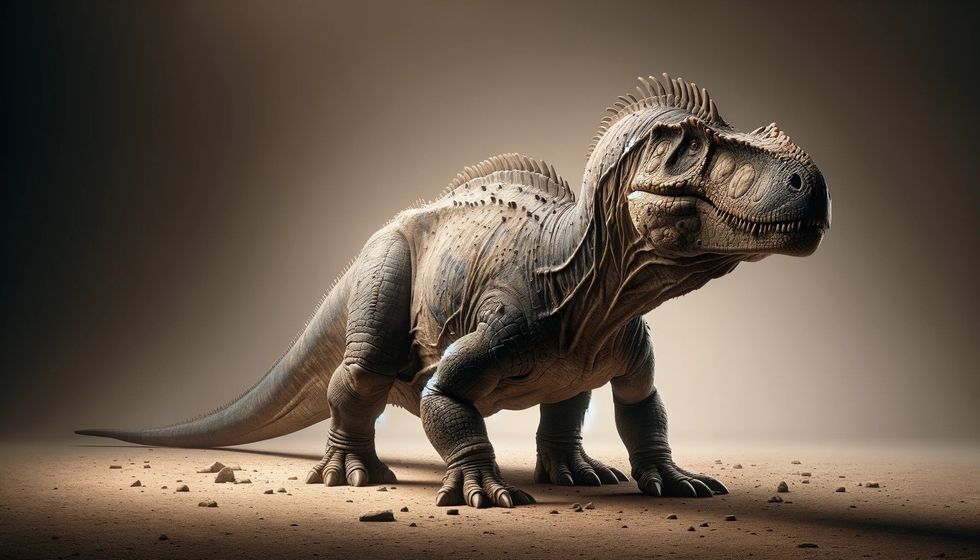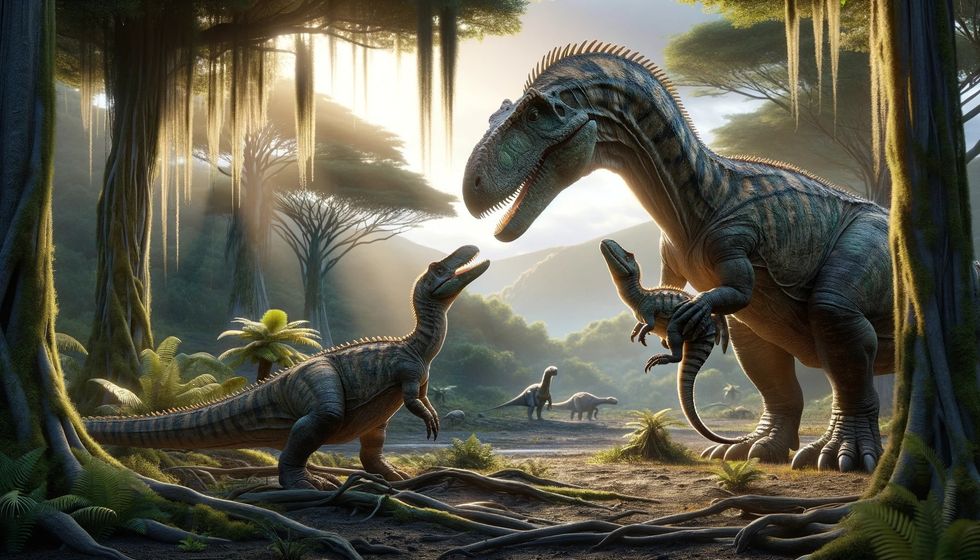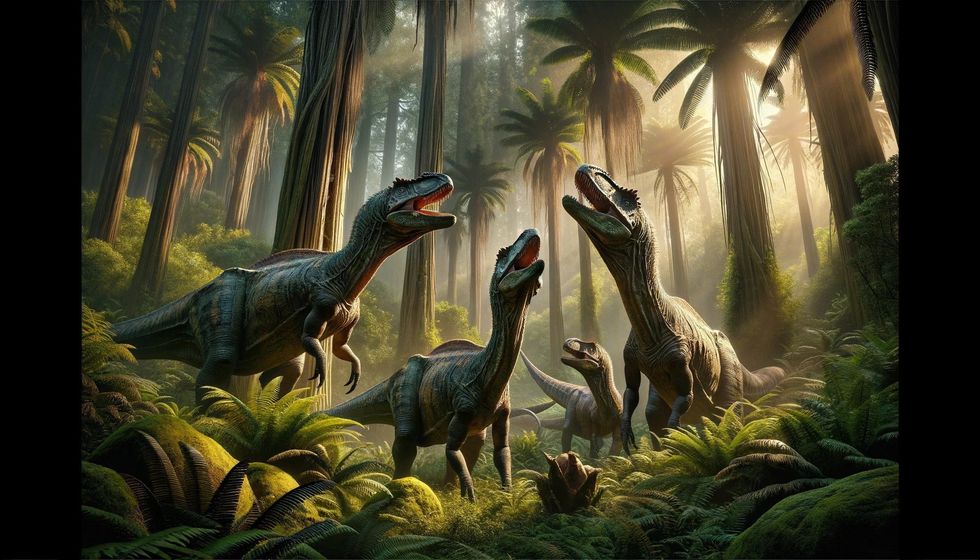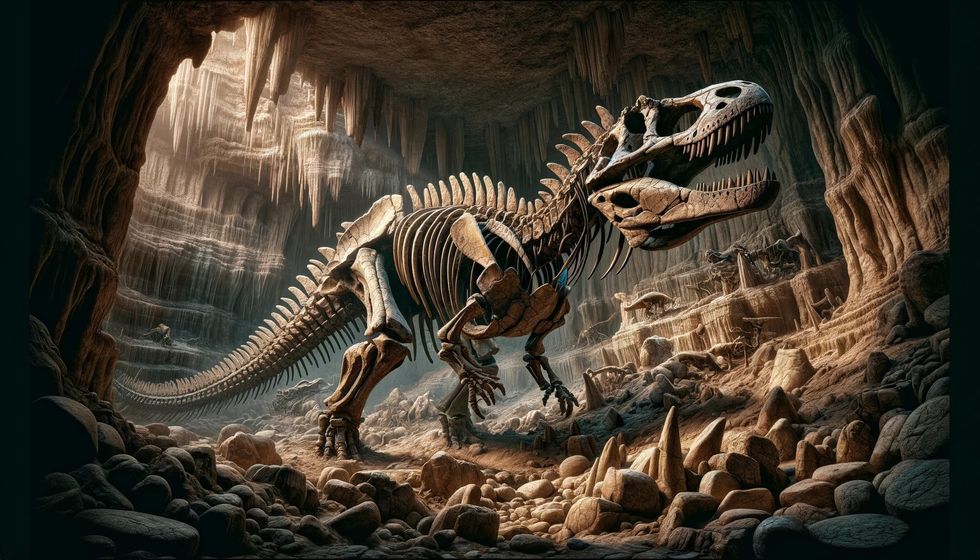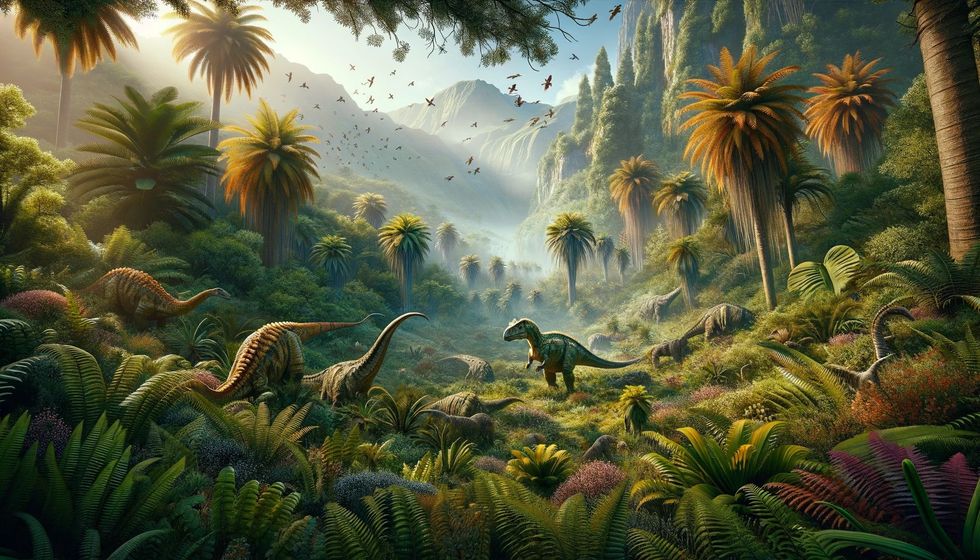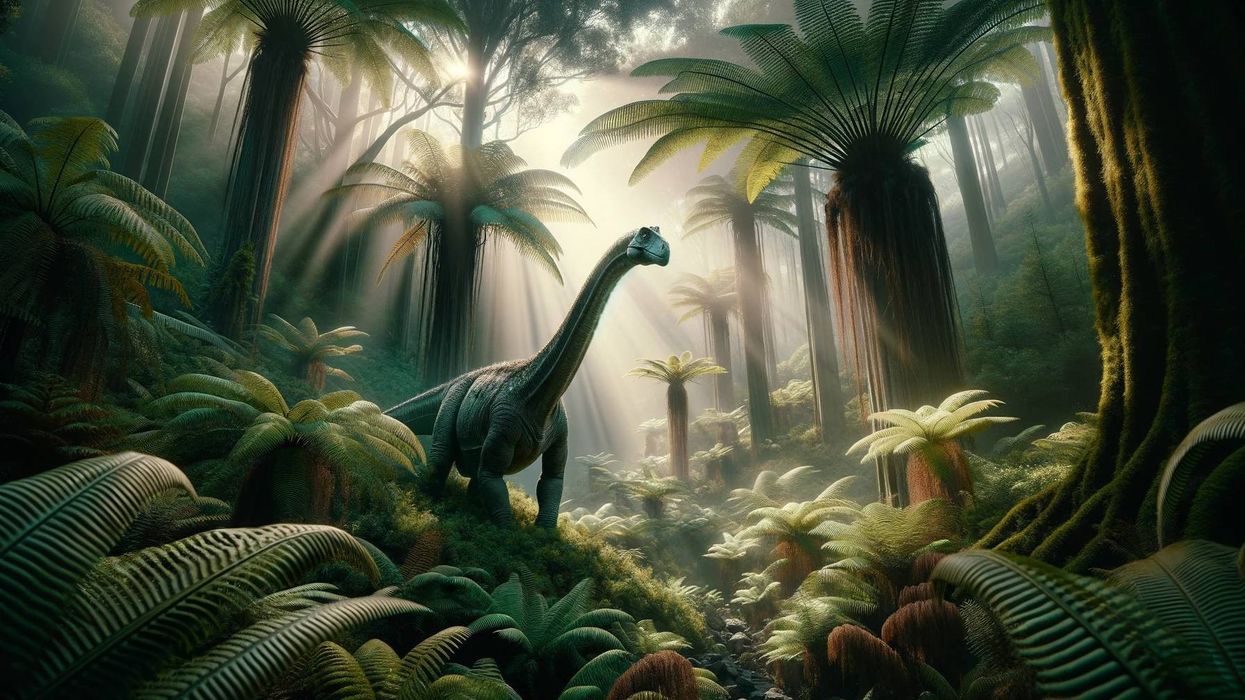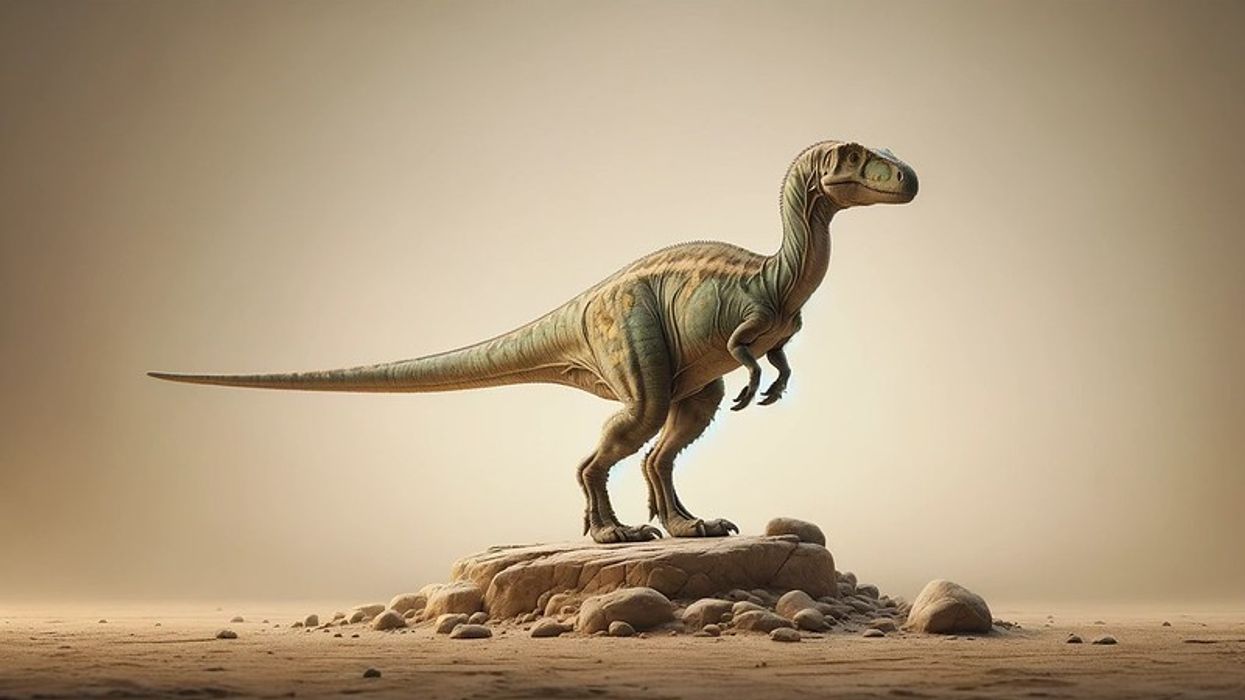The Anodontosaurus, whose name resonates with the intriguing appeal of paleontological marvels, is a testament to the diverse and complex tapestry of dinosaur life that once flourished in the Late Cretaceous Period (71-70.2 million years ago) of Alberta, Canada.
Fossils unearthed from ancient sediments paint the portrait of an extinct genus of armored giants that dominated the terrestrial landscapes of Western North America.
The Anodontosaurus, belonging to the formidable ankylosaurid dinosaurs, was well-adapted to life under the shadow of towering conifers and ferns that dotted its habitat.
A venture into the depths of vertebrate paleontology reveals that the Anodontosaurus was not alone; rather, it coexisted alongside other remarkable species within the robust ecosystems surrounding the Red Deer River. This river meanders like a lifeline through the heart of Southern Alberta, defining an era marked by the incredible diversity of prehistoric fauna.
Paramount to understanding the Anodontosaurus is recognizing its dietary habits as a diet herbivore. It thrived on the lush vegetative growth that blanketed the region, feeding primarily on the abundant plant matter.
The Anodontosaurus was encased in an impressive suit of natural armor. Rows of small polygonal plates, akin to a chainmail vest, shielded its body, while its iconic tail club stood as a symbol of defense and evolutionary innovation.
It is within the walls of formations like the Dinosaur Park Formation and the Horseshoe Canyon Formation where the vestiges of this ankylosaurid's existence have been meticulously preserved, allowing humanity to marvel at a creature perfectly engineered by natural selection to endure the challenges of its time and territory.
Anodontosaurus Interesting Facts

How do you pronounce 'Anodontosaurus'?
Anodontosaurus is pronounced as 'ANN-oh-DON-toe-SORE-us'.
What type of dinosaur was an Anodontosaurus?
The Anodontosaurus was an ankylosaurid dinosaur, a type of armored dinosaur known for its extensive dermal armor and clubbed tail.
In which geological period did Anodontosaurus roam the Earth?
The Anodontosaurus roamed the Earth during the Late Cretaceous Period (71-70.2 million years ago).
When did the Anodontosaurus become extinct?
The Anodontosaurus became extinct at the end of the Cretaceous Period, around the same time as the mass extinction event that wiped out the dinosaurs.
Where did the Anodontosaurus live?
The Anodontosaurus lived in what is now Alberta, Canada.
What was the Anodontosaurus' habitat?
The habitat of the Anodontosaurus was the lush forests and floodplains that featured prominently in the geological landscape of the Late Cretaceous.
Who did the Anodontosaurus live with?

The Anodontosaurus likely lived in herds or small groups, though definitive social structures of these dinosaurs are still under study.
How long did an Anodontosaurus live?
The lifespan of an Anodontosaurus is not precisely known, but ankylosaurids may have lived for several decades based on their large size and growth patterns.
How did the Anodontosaurus reproduce?
Like other dinosaurs, the Anodontosaurus likely reproduced by laying eggs.
Anodontosaurus Fun Facts
What did Anodontosaurus look like?

The Anodontosaurus was a toothless armored dinosaur with heavily fortified skin consisting of osteoderms or bony plates, culminating in a formidable tail club used for defense.
How many bones did an Anodontosaurus have?
The exact number of bones an Anodontosaurus had is not known, but like other ankylosaurids, it would have had a complex skeletal structure to support its armor.
How did the Anodontosaurus communicate?
Although not much is known about the specific communication methods of Anodontosaurus, it's likely that, like other dinosaurs, they used visual and auditory signals.
How big were the Anodontosaurus?
The Anodontosaurus reached lengths of around 13-16 ft (4-5 m) from its snout to the tip of its tail club.
How fast could an Anodontosaurus move?
The heavy armor of the Anodontosaurus suggests that it was not a fast mover, and it likely had a slow, lumbering gait.
How much did an Anodontosaurus weigh?
An Anodontosaurus weighed between 3,968-4,630 lb (1,800-2,100 kg).
What were the male and female names of the Anodontosaurus?

There are no specific names for male or female Anodontosaurus; they are simply referred to by their genus name.
What would you call a baby Anodontosaurus?
A baby Anodontosaurus would likely be called a 'hatchling' or 'juvenile'.
How aggressive were the Anodontosaurus?
The Anodontosaurus were not aggressive predators as they were herbivores, but their tail clubs suggest they could be formidable when defending against predators.
Did you know...

The Anodontosaurus was once thought to be a juvenile form of the well-known armored dinosaur Euoplocephalus but is now recognized as its own distinct genus.
The 'Canada Department of Mines - Geological Survey Bulletin' has been an invaluable resource in the study of the Anodontosaurus, revealing important facts about its morphology and behavior.
It is through the meticulous work documented in publications like this bulletin that paleontologists have been able to construct a clearer image of the Anodontosaurus as a notable member of the ankylosaurid dinosaurs, characterized by its distinctive tail club and armored body.
These insights have deepened human understanding of the Anodontosaurus' role in its Late Cretaceous ecosystem and have provided context to the fossilized remains uncovered in the fossil-rich formations of Alberta, Canada.
The Anodontosaurus, aptly described as a 'toothless armored dinosaur', intrigues paleontologists due to its unique dental composition. Unlike the robust, grinding teeth found in many of its contemporaries, Anodontosaurus had significantly reduced, smaller teeth, which contributed to the 'toothless' misnomer.
These smaller teeth were more adept for a diet consisting mainly of soft vegetation, a fact that highlights the specialized feeding adaptations this ankylosaurid dinosaur evolved to thrive in the diverse ecosystems of the Late Cretaceous Period.
The Anodontosaurus, as a distinctive member of the ankylosaurid dinosaur group, is renowned for its heavily armored body and the presence of a formidable tail club. This specialized adaptation provided it with a powerful defensive apparatus against predators, solidifying its status as one of the most well-protected herbivores within the dynamic ecosystems of the Late Cretaceous Period.
The Anodontosaurus thrived during the Cretaceous of Alberta, Canada, a time characterized by rich biodiversity and abundant plant life, which provided the perfect environment for this herbivorous species to flourish.
The fossils found in this region have shed light on the existence of this ancient creature, offering a glimpse into its role in the prehistoric ecosystems that once dotted the Canadian landscape.
The Anodontosaurus, often mistaken for the armored dinosaur Euoplocephalus due to their similar features, was actually a distinct species that roamed the Cretaceous of Alberta, Canada. One key difference between these two ankylosaurid relatives is the unique arrangement and shape of their bony armor, underscoring Anodontosaurus' individual identity in the fossil record of this region.
In the field of earth sciences, the study of the Anodontosaurus has provided significant insights into the Late Cretaceous faunal assemblages. This genus of ankylosaurid dinosaurs has become a subject of interest for its peculiar characteristics, such as the distinctive tail club and its armored body, broadening our understanding of dinosaurian adaptations and diversity within their ancient habitats.
The Anodontosaurus stood out among its contemporaries with a highly specialized feature located at its immediate rear: a massive, bony tail club. This evolutionary marvel served as a powerful weapon, providing the dinosaur with a means of defense against predators that might have lurked in its Cretaceous habitat.
This tail club is one of the most recognizable characteristics of the Anodontosaurus, emphasizing its unique place in the dinosaur kingdom.
Within the pages of a zoological journal, you may come across the fascinating Anodontosaurus, an ankylosaurid heralded for its elaborate armor and striking tail club. This herbivorous dinosaur's extensive osteoderms and distinctive defensive structures have made it the subject of numerous scholarly articles, enriching our collective knowledge of dinosaur morphology and behavior during the Late Cretaceous Era.
The Anodontosaurus is notably associated with the Maastrichtian stage of the Late Cretaceous, which is the final chapter of the dinosaur era. The fossil records from this period provide evidence of the Anodontosaurus' existence and its survival strategies during a time of significant geological and ecological changes that preceded the mass extinction event.
The Anodontosaurus, a dinosaur from the Late Cretaceous Period, is distinguished by its specialized form of defense; a robust tail club, and thick, bony armor. This impressive adaptation marks it as one of the most formidable herbivorous dinosaurs of its time, showcasing the diverse evolutionary paths taken by creatures during this transformative era in Earth's history.
The Anodontosaurus, which also lived during the mid-late Campanian stage of the Late Cretaceous, provides a window into the biodiversity and complexity of prehistoric ecosystems.
This timeframe marks a significant period when the Anodontosaurus, with its robust armor and defensive tail club, thrived among its contemporaries, coexisting with a variety of other dinosaur species prior to the Cretaceous-Paleogene extinction event.
Through revised systematics utilizing advanced paleontological techniques, researchers have determined that the Anodontosaurus was a distinct genus that flourished in the mid-late Campanian stage.
These systematic revisions have clarified the evolutionary relationships within the Ankylosauridae family and underscored the unique adaptations of the Anodontosaurus, such as its armor and tail club, that enabled it to navigate its prehistoric world successfully.
The genus Anodontosaurus is currently recognized to include at least two species, which are distinguished by subtle variations in their skeletal features, including differences in their armor and the structure of their tail clubs. This diversity within the genus highlights the evolutionary complexity and adaptability of the Anodontosaurus within the diverse ecosystems of the Late Cretaceous Period.
FAQs
Did Anodontosaurus have teeth?
The Anodontosaurus, as suggested by its name, which translates to 'toothless lizard', is known for its distinct lack of huge teeth, especially when compared to other members of the Ankylosauridae family. This unique characteristic is among the defining features of the genus.
Despite the generalized term 'toothless', it is important to note that the Anodontosaurus did possess small, flat teeth, but these were not well-suited for grinding or chewing.
Instead, their dental structure was adapted more towards stripping and cropping vegetation rather than intricate mastication. This dietary adaptation indicates that the Anodontosaurus likely processed its food in a different manner from many of its contemporaries, possibly relying on gastroliths or stomach stones to aid in the digestion of tough plant material, a common trait among various herbivorous dinosaurs.
Where was Anodontosaurus found?
Anodontosaurus fossils have been uncovered primarily in the Western part of North America. The most significant and revealing finds have originated from the sedimentary layers in Southern Alberta, Canada, within well-known formations such as the Horseshoe Canyon Formation and the Dinosaur Park Formation.
These formations are part of a larger geological series known as the Upper Cretaceous strata, which details a period in Earth's history where conditions were ripe for the preservation of dinosaur remains.
These regions, with their deep historical records, have become vital to understanding the distribution and habitat preferences of the Anodontosaurus, and they continue to be areas of significant paleontological research.
How much did Anodontosaurus weigh?
The Anodontosaurus was a sizeable ankylosaurid, and its weight is estimated based on skeletal remains and comparison with related species. Although there is variability in size among individuals, the Anodontosaurus typically weighed between 3,968-4,630 lb (1,800-2,100 kg).
This substantial weight is consistent with the heavily armored nature of these dinosaurs, as their extensive osteoderm coverage and robust skeletal structure contributed significantly to their overall mass.
The Anodontosaurus represents an intriguing chapter in the ancient saga of dinosaur evolution. Its existence in the entire span of the Late Cretaceous across the terrains of Alberta, Canada, underscores the diversity and adaptability of ankylosaurid dinosaurs.
With a suite of defensive traits that evoke the images of medieval warriors clad in armor, the Anodontosaurus captures the imagination and provides an inspiring glimpse into the planet's prehistoric past.
From Your Site Articles
Related Articles Around the Web


